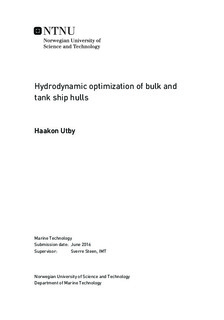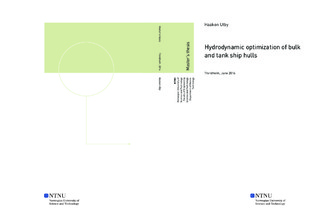| dc.description.abstract | International shipping transports more than 80 percent of global trade. Traditionally bulk carriers have been built to minimize construction cost and maximize cargo-carrying capacity, neglecting hydrodynamic characteristics. By 2025, all new ships will be required to be 30% more energy efficient than those built in 2014.
When designing bulk ships, a number of restrictions have already been applied even before the naval architect has stated designing the ship, e.g. port restrictions, canals and legislative limitations. This thesis investigate how speed performance and power requirements may be improved by lifting some of the restriction on main dimensions when designing ship hulls. Lindstad et al. (2013) introduce the idea that increasing the breadth of bulk carriers while keeping the length, draft and displacement constant, and thereby reducing the block coefficient, will be an efficient way of reducing the resistance and fuel consumption of a ship.
Lindstad et al. (2013) uses an empirical model based on Holtrop and Mennen (1984) and conclude that the brake power is reduced with reduced block coefficient. However, when evaluating hull dimensions outside the range the empirical data is based on, the result obtained has high uncertainty. Numerical methods using CFD has been applied in combination with CAD program to optimize hull lines. Using CFD to calculate added resistance in waves is however very computational demanding and time consuming and can hardly be applied in an optimization process. By using a simplified numerical method on a wide range of hull designs, this thesis attempts to bridge the gap between the idea of Lindstad et al. (2013) and the numerical approach used in simulation based design.
Based on an adaption of a commercial bulk carrier (CBC) and MOERI KVLCC2 there has been designed two series of ships with a deadweight of 80 000 tons. The block coefficient varies from 0,59 to 0,8 for the MOERI KVLCC2 series and 0,64 to 0,87 for the CBC series. When designing the hull and ship lines the focus has been on optimizing the bow, the transition between the bow and parallel midship area (forward shoulder), the parallel midship body and the stern area.
Initially, the two numerical calculations programs ShipX and Michlet was tested. ShipX calculates the wave resistance of conventional monohull ships using potential theory. To make ShipX more robust it satisfies the boundary condition of the surface some distance away from the hull surface. The satisfying of the boundary condition makes it less prone to catch details in different hulls. Using Geritsma & Beukelman method combined with strip-theory approximation the added resistance in waves is calculated. Michlet is an open source research code utilizing thin ship theory to calculate wave resistance. The essential assumption is that the hull is thin, that is, the breadth is small compared to all other characteristic lengths of the problem. A benchmarking with the MOERI KVLCC2 show that results from ShipX are correlating best with experimental results. ShipX is therefore used to calculate the calm water resistance and added resistance in waves for the two design series.
When comparing the brake power as a function of block coefficient calculated using empirical and numerical methods there is a clear disagreement in the results. For both of the design series the empirical calculations show a decreasing brake power with decreasing block coefficient, giving no clear optimum. For the CBC series the numerical calculations show an optimal block coefficient of 0,73. For the MOERI KVLCC2 series the numerical calculations show an optimal block coefficient of 0,78. In additions, results indicate that for a given block coefficient moving the longitudinal center of buoyancy (LCB) backward reduce the wave resistance.
From the results it is concluded that the optimal block coefficient for ships in the New Panamax and Capesize segment (60 000 | |

